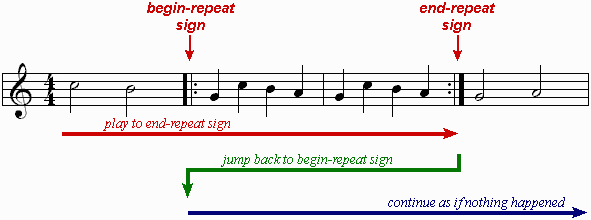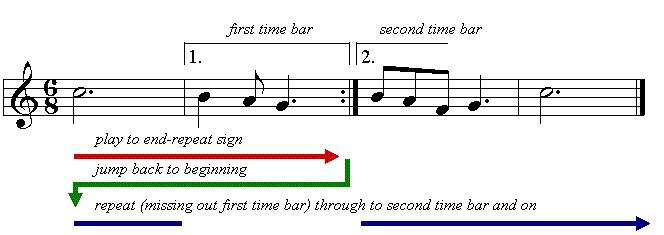|
Repeated Notes
::

|
Key words:
repeated notes
abbreviations
tremolo |
| 1 |
Repeated Notes
 We set out above some examples of signs, called abbreviations, used to represent repeated notes. The upper line shows the notation itself and the lower line shows what each sign represents. The time value shown by the note-head tells us how much time we have to play the repeated notes. The time value of the repeated note will be either an undotted quaver, semiquaver, demisemiquaver or shorter, depending on the number of strokes across the stem. The number of repeated notes is the ratio of the time value of the note head to the time value of the repeated note. If the note does not have a stem (e.g. a semibreve) then the strokes lie below the note-head.
bar 1 : a standard crotchet;
bar 2 : two repeated quavers (one stroke=one flag) in the time of one crotchet;
bar 3 : four repeated semiquavers (two strokes=two flags) in the time of one crotchet;
bar 4 : eight repeated demisemiquavers (three strokes=three flags) in the time of one crotchet;
bar 5 : three repeated quavers in the time of one dotted crotchet;
bar 6 : four repeated quavers in the time of one minim;
bar 7 : two repeated semiquavers in the time of one quaver beamed to another two repeated semiquavers in the time of one quaver.
The repetition of a single note, as fast as possible, is called tremolo.
In addition to repeated single notes, a similar notation is used to show repeated chordal patterns. Two examples of this are given below. Note that the number of strokes shows the time value of the individual notes in the pattern while the note value shows the duration of the pattern itself.

|
|
|
Repeated Groups
::

|
Key words:
repeated groups
tremolo legato
tremolo non legato
simile marks |
| 1 |
Repeated Groups
Where the pattern to be repeated is a pair of notes a certain interval apart, rather than individual notes as in the earlier example, the strokes are used, in effect, like beams. These repeated pairs are called alternations. The duration of the pattern is given by the time value of first of the pair of notes. The second note, marked with identical duration, confirms the pattern interval.  bar 1 : sixteen semiquavers (two strokes=two flags) in the time of one semibreve;
bar 2 : twelve semiquavers (two strokes=two flags) in the time of one dotted minim;
bar 3 : eight semiquavers (two strokes=two flags) in the time of one minim;
bar 4 : four semiquavers (two strokes=two flags) in the time of one crotchet. Composers may use this notation when they want a tremolo effect. In this case the repetition should be fast avoiding an recognizable regularity in the effect. It is called tremolo legato if under a single slur, or tremolo non legato if the slur is absent.
If the use of semiquavers (16th notes) in music that is too slow does not produce a convincing effect, shorter notes, demisemiquavers (32nd notes), would be used and the composer would indicate this by using three strokes instead of two. When larger groups of notes or chords are repeated, strokes, called simile marks are placed between the second and fourth lines of the stave.
We give some examples below.  bar 1 : repeated chords - a single oblique stroke, one single stroke per chord whatever its note value;
bar 2 : repeated semiquaver pattern - two oblique strokes (two strokes=two flags) - if quavers, one stroke; if demisemiquavers, three strokes;
bar 3 : repeated pattern of mixed notes - two oblique strokes within two dots.
|
|
|
Repeated Bars
::

|
Key words:
repeated bars
simile marks |
| 1 |
Repeated Bars
When individual bars are to be repeated, the composer may use a different type of abbreviation, a single oblique stroke between two dots in the bar or bars following. Like the oblique strokes used for repeated groups of notes which we introduced in the previous section, these too are called simile marks. If a short passage of two or three bars is to be repeated then the phrase itself might be highlighted with a line with square ends lying above the bar and the word bis in the middle of the line. We illustrate both of these below.  
|
|
|
Repeated Whole Bar Rests
::

|
Key word:
repeated whole bar rests |
| 1 |
Repeated Whole Bar Rests
Whole bar rests can be collected together and the number of consecutive whole bar rest shown by a single rest sign over which the number is written. If this sequence of rests included section ending then it is good practice to collect them within each section and separate the sections with a double bar made up of two thin vertical lines. 
|
|
|
Repeated Sections
::

|
Key word:
repeated sections |
| 1 |
Repeated Sections
The most common device for repeating sections is the repeat mark which we show below - a pair of lines, one thick and the other thin, with two, or sometime four dots, which are placed to the left of the thinner line if an 'end repeat' or to the right of the thinner line if a 'begin repeat'. Notice that if the first section repeated lies at the beginning of the piece no 'begin repeat' sign is needed but for sections lying within the piece the composer must mark both the beginning and end of the section. It is good practice for the open (left-hand) repeat of a repeated section to be placed at the beginning of a line as this makes it much easier to find the beginning of the repeat when sight reading.
 If the piece starts with a 'short' bar (the piece below is in 4 but has only 2 beats in the first bar) and the composer wants the piece repeated from the beginning, the first repeat mark lies in the middle of a bar so that the time value of the opening 'short' bar taken with the time value of the 'shortened' bar immediately before the repeat mark totals the time value of a whole bar. To see how repeat signs work, examine the schematic below:  Sometimes the last few bars of a passage to be repeated may be altered when played a second time. To make this clear, 'first time' (in Italian prima volta) and 'second time' (in Italian seconda volta) marks can be placed over the relevent bars; as shown below. The 'second time' mark is open to the right because it leads to new material.

|
|
|
Da Capo
::

|
Key words:
da capo
del segno
fine
coda |
| 1 |
Da Capo
Sometimes instructions are given that mean one repeats different sections from different places. For this a number of Italian instructions are used which we summarise below. | Instruction | Meaning | What You Must Do | | D.C. al Fine | D.C. (da capo) = from the start
Fine = end | go back to the beginning and end at Fine | | D.C. al Coda | D.C. (da capo) = from the start
Coda = tail | go back to the beginning and play to the coda sign, then skip to and play the Coda | | D.S. al Fine | D.S. (del segno) = from the sign
Fine = end | go back to the sign and end at Fine | | D.S. al Coda | D.S. (del segno) = from the sign
Coda = tail | go back to the sign and play to the to coda instruction, then skip to and play the Coda, which is marked with the Coda sign, a circle with crosshairs |
 |
segno = sign | the modern form of the older signum sign indicating a place from which an additional instruction should be observed, as, for example, go back to the 'sign' and then 'do something' |
 | coda sign | jump from the al Coda or 'to Coda' instruction, to the section marked with the Coda sign, missing out all the bars between the al Coda or 'to Coda' instruction and the Coda sign itself (corrected by Kim Krenzer) |
| Fine | end | marking the place where the music stops |
|
|
|
Minuet & Trio
::

|
Key words:
minuet
trio
ABA structure |
| 1 |
Minuet & Trio
It is a 'convention', when playing a minuet followed by a trio section, that the minuet is played again after the end of the trio section but without any sectional repeats. This is sometimes called A-B-A structure, i.e. A, the minuet (with repeats, if there are any), B, the trio section (with repeats, if there are any), A the minuet again (without repeats). A similar 'convention' is adopted with paired movements in early eighteenth-century dance suites, for example, a pair of minuets. The second minuet is played between two performances of the first, the second performance of the first minuet being played without sectional repeats.
|
|
 :: next lesson :: next lesson
| |
 :: next lesson
:: next lesson